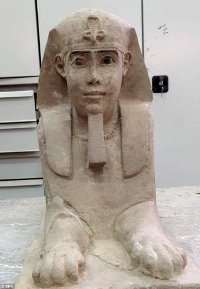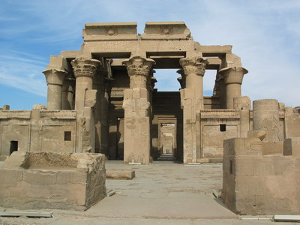|
Sandstone Sphinx Found at Kom Ombo Temple
September 16, 2018
Another sphinx has emerged from antiquity. This one, found in the famed Kom Ombo temple, is made of sandstone. Archaeologists were draining water from the Kom Ombo temple when they found the sphinx, in an area that had already yielded a pair of sandstone reliefs from the reign of King Ptolemy V. The sphinx dates to the Ptolemaic era as well, the archaeologists said. This sphinx is in the shape of the classically defined one, with the head of a person and the body of a lion. Finds of this kind have been relatively rare; much more commonly found is a sphinx with the body of a lion and the head of a ram. The most famous human-lion sphinx is the giant one at Giza, near the pyramids; that sphinx is made of limestone. Other materials used to craft known sphinxes include alabaster (found near Memphis) and granite (featuring the head of the famed female pharaoh Hatshepsut). The Ptolemies ruled Egypt for nearly three centuries, from the advent of Ptolemy I, once a loyal lieutenant of Alexander the Great, in 305 B.C. until the Roman conquest, in 30 B.C. The Temple of Kom Ombo is rather unusual in that it was dedicated to two gods. In effect, it is a complex consisting of two parallel temples. The northern half of the Greco-Roman temple was dedicated to the falcon god Horus; the southern half was dedicated to the crododile god Sobek. Among the engravings inside the temple are what are thought to be the first known Egyptian depiction of medical instruments. Horus was also believed to be a doctor. Construction on the temple begin in the 4th Century B.C. and continued for decades thereafter. The temple, famous for its crocodile statues, is near a small Nile River town of the same name, about 45 kilometers (27 miles) north of Aswan and about 800 kilometers (497 miles) south of Cairo. Archaeologists in April 2018 found a bust of the Roman emperor Marcus Aurelius there. As with other such discoveries, Egypt's Antiquities Ministry hopes for a consequent increase in tourism. An earlier sphinx find stopped construction along the Al-Kabbash Road. Just a few weeks before, archaeologists announced that they had found a Nile Delta village that predates the pharaohs. The site is in Tell el-Samara an dates to 5000 B.C., some 2,500 years before the building of the Giza pyramids. And in July 2018, archaeologists excavating in Giza's western necropolis unearthed a 4,400-year-old tomb belonging to a high-ranking priestess. |
Social Studies for Kids |
Social Studies for Kids
copyright 2002–2019
David White






